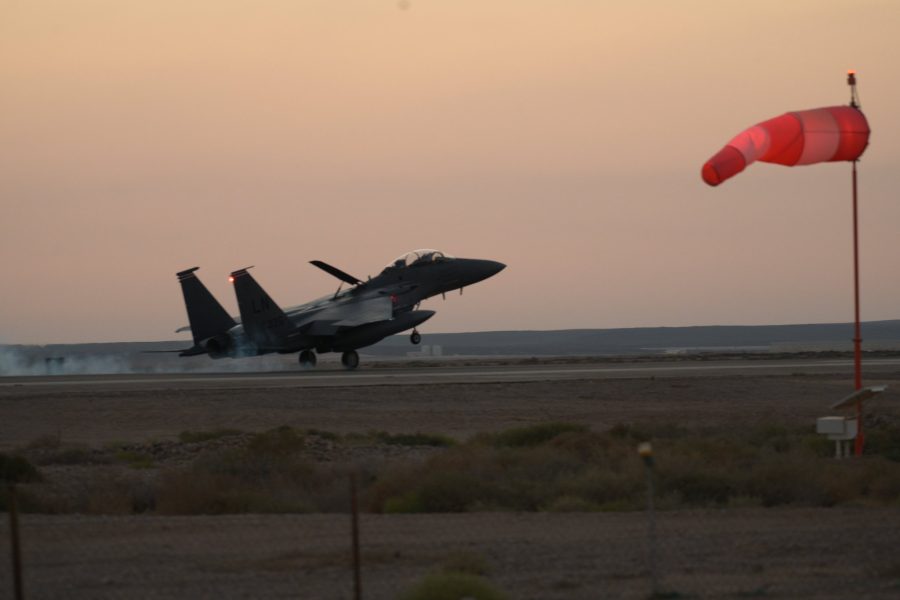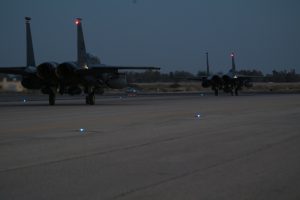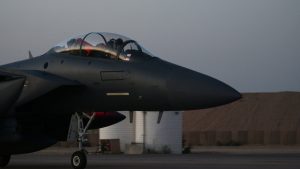F-15Es arrived in the Middle East on Oct. 13, as the U.S. continued to bolster its forces in the region, the U.S. Air Force announced.
The planes, which deployed from RAF Lakenheath, U.K., are part of a broader package of forces that have been deployed after Hamas’ attack on Israel, including an increased number of A-10 Thunderbolt II close air support aircraft and F-16 Fighting Falcon multirole fighters.
“The aircraft’s advanced systems and targeting capabilities enable U.S. forces to respond to any crisis or contingency, and if necessary, engage and defeat adversaries,” Air Forces Central (AFCENT) said in a statement announcing the arrival of the F-15Es.
The Pentagon did not say where the F-15Es would be based. Their arrival comes one day after the Pentagon announced A-10 Warthogs from the 354th Fighter Squadron at Davis-Monthan Air Force Base, Ariz., had arrived in the region, in addition to the Warthogs from the 75th Fighter Squadron already in the region.
U.S. officials have said that U.S. Air Force F-35 Lightning II stealth fighters are among the additional capabilities that could be sent
“The U.S. military is committed to the enduring safety and security across the Middle East,” AFCENT commander Lt. Gen. Alexus G. Grynkewich said in an Oct. 13 statement. “By posturing advanced fighters and integrating with joint and coalition forces, we are strengthening our partnerships and reinforcing security in the region.”
U.S. Secretary of Defense Lloyd J. Austin III, who arrived in Israel on Oct. 13, met with Israel’s Prime Minister Benjamin Netanyahu, Minister of Defense Yoav Gallant, and the Israel’s newly-formed war cabinet.
Austin highlighted the “bolstered” USAF presence in the Middle East and the deployment of the USS Gerard R. Ford in the Eastern Mediterranean, according to a readout of Austin’s meetings provided by Pentagon Press Secretary Air Force Brig. Gen. Patrick S. Ryder.
Upon returning to the U.S., Austin also dispatched the USS Dwight D. Eisenhower to the region, the Pentagon announced Oct. 14.
The new U.S. assets are aimed at discouraging Hezbollah, the Lebanese militant group, Iran, or other groups from trying to escalate the conflict and to show support for Israel, which has had more than 1,300 citizens killed and others taken hostage and brought to Gaza. American citizens are among the dead and taken hostage by Hamas, the U.S. government says. The State Department has announced plans to evacuate some American citizens from Israel.
“We’ve augmented U.S. fighter aircraft squadrons in the Middle East, and the U.S. Department of Defense stands fully ready to deploy additional assets, if necessary,” Austin said during a press conference in Israel on Oct. 13.
In addition to the Air Force fighters, the USS Ford also carries four F/A-18 Super Hornet fighter squadrons, as well as electronic warfare and command and control aircraft. The carrier is also accompanied by cruise missile-carrying warships.
Ryder added that the U.S. was “expediting security assistance to Israel, including precision guided munitions and air defense ammunition.” Austin also “committed to deploying additional assets as needed.” U.S. officials have said that U.S. Air Force F-35 Lightning II stealth fighters are among the further capabilities that could be sent.
Some of the additional assets Austin referenced are on their way.
The USS Dwight D. Eisenhower aircraft carrier was set to sail from Norfolk, Va., on Oct. 13, but its deployment was temporarily delayed, according to local media reports. The next day, the Pentagon said the Eisenhower and its accompanying warships would join the Ford in the Eastern Mediterranean. Embarked aboard the Eisenhower is Carrier Air Wing 3, which typically has four fighter squadrons as well as other aircraft. The Pentagon said the Eisenhower would be carrying nine aircraft squadrons of various types on its new deployment. Like the Ford, it is joined by multiple cruise missile-carrying warships.
In a statement issued on Oct. 14, Austin said the deployment of the Eisenhower to the Eastern Mediterranean was part of the U.S. effort to “deter hostile actions against Israel or any efforts toward widening this war.”
Israel has responded to the Hamas attacks with punishing airstrikes in Gaza, and Israeli ground forces appears posed to intervene, with large numbers of the Israel Defense Forces (IDF) staging near Israel’s border with Gaza and issuing warnings to evacuate. Netanyahu has vowed to “crush and destroy” Hamas.
During his visit, Austin signaled strong support for Israel.
“This is no time for neutrality, or for false equivalence, or for excuses for the inexcusable,” Austin said at an Oct. 13 press conference. “Make no mistake: the United States will make sure that Israel has what it needs to defend itself, and Israel has a right to protect its people.”



